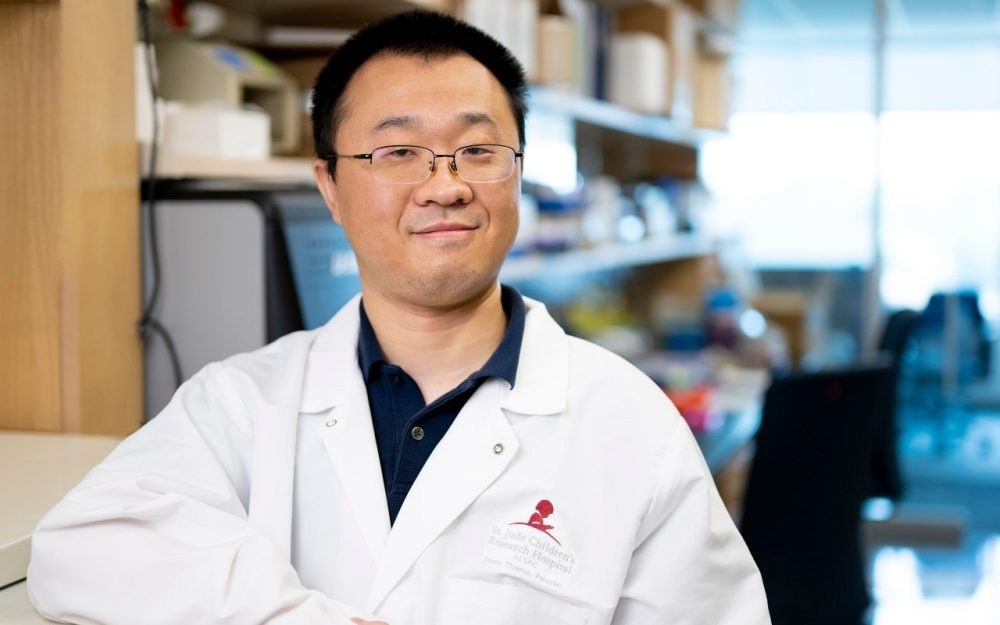The potential of CAR T-cell therapy for the treatment of solid tumors was unlocked in a preclinical trial by researchers at St. Jude Children’s Research Hospital who discovered a molecular mechanism. The findings were released in the journal Nature.
 Ao Guo, PhD, postdoctoral research associate and first author of the Nature study. Image Credit: St. Jude Children’s Research Hospital.
Ao Guo, PhD, postdoctoral research associate and first author of the Nature study. Image Credit: St. Jude Children’s Research Hospital.
Our work extends from the basic biology of T lymphocytes to a possible application in the clinic, with an exploration of deep molecular mechanisms along the way. We found that just like many of us, if you are an activated T cell, things that happen early in your life can impact your later development. We identified that an interaction between the protein c-Myc and the complex cBAF early in T-cell activation influences cell fate trajectory.”
Doug Green PhD, Study Corresponding Author and Chair, Department of Immunology, St. Jude Children’s Research Hospital
A kind of immunotherapy known as chimeric antigen receptor (CAR) T cells alters a patient’s immune system to specifically target cancer cells. Adults and children with leukemia and lymphoma have had exceptional success with this sort of therapy, especially in relapsed patients. However, due to issues with persistence and function, CAR T cells have not been as effective against solid tumors.
Too many CAR T cells are now turning into effector cells, which are cells that destroy malignant or diseased cells. Too few develop into memory cells that survive over time and eventually produce new T cells. The team thought that by producing more memory cells, CAR T-cell treatment may be enhanced.
Effector cells do a job and then die. Memory cells stick around and can generate effector cells (while maintaining the memory cell pool) and therefore they can launch continued attacks. So, we think that memory cells likely do a better job of getting rid of tumors.”
Doug Green PhD, Study Corresponding Author and Chair, Department of Immunology, St. Jude Children’s Research Hospital
A molecular mystery
To change the process, the researchers sought to understand what triggers T cells to differentiate into effector or memory kinds. When a T cell is triggered by an antigen, such as a virus or cancer-related chemical, the process gets started. Two daughter cells, which can develop into effector or memory cells, are produced when that primary T cell splits.
The distribution of the protein c-Myc in a parental T cell has recently been demonstrated by Green’s team to play a role in this process. Researchers were aware that an effector cell develops from a daughter cell with increased c-Myc. The researchers in this work discovered interactions between c-Myc and the protein complex known as cBAF (canonical Brg1/Brg-associated factor). Effector T cells were produced from daughter cells with high cBAF and c-Myc levels.
Certain chromatin regions and proteins on DNA are bound by cBAF. According to the research, it may exert control on the expression of genes associated with effector cells to direct cell fate, or the type of T cell that is produced.
The researchers concluded that cell destiny is chosen early in the immune response when they noticed the distribution of cBAF in the first activated T cell that starts the adaptive immune response.
A fortuitous finding and collaboration
Co-corresponding author Hongbo Chi, PhD of the St. Jude Department of Immunology, was researching how a T cell turns into a memory cell at the same time as Dr Green’s team was investigating T cell divisions. The CRISPR genetic screening technique was utilized in Chi’s lab to delete genes and study the effects on T-cell fate.
T cells represent a cornerstone for cancer immunotherapy. There is a continuing interest in improving T-cell function for better cancer treatment. As such, my lab is interested in identifying metabolic drivers in T-cell memory responses. Given the crosstalk between metabolic and epigenetic pathways, we did an in vivo CRISPR screen of epigenetic regulators of T-cell memory. That led us to cBAF.”
Hongbo Chi, Study Co-Corresponding Author, Department of Immunology, St. Jude Children’s Research Hospital
Green added, “We were looking at what happens to components of the cBAF complex in activated T cells. At the same time, the Chi lab had been fishing in a pond filled with molecules that might influence the cell fate to generate effector versus memory T cells. When we compared notes, we realized that our independent findings were telling us something interesting, so we joined forces.”
Together, the teams were able to demonstrate that memory T-cell production is impacted when different cBAF complex components are targeted. Additionally, the scientists identified the precise genomic regions where cBAF components attach and discovered that cBAF boosted the expression of genes linked to effector cell activity.
Together against tumors
The researchers increased CAR T-cell effectiveness by making use of the molecular information they obtained. To increase the production of memory T cells, scientists used a cBAF inhibitor during CAR T-cell activation. The T cells treated with the inhibitor had superior tumor growth control than untreated cells in a preclinical model. Additionally, more of the treated cells survived and multiplied.
The encouraging findings were repeated by the researchers in other solid tumor varieties. This work is among the first to demonstrate that CAR T cells may be temporarily changed to more efficiently eradicate solid tumors.
“cBAF factors are a potential target to boost CAR-T therapeutic effects against cancer, but our work also demonstrates that by better understanding basic immunobiology and T cell function, we can develop better therapeutics for cancer and other diseases,” Chi concluded.
Source:
Journal reference:
Guo, A., et al. (2022) cBAF complex components and MYC cooperate early in CD8+ T cell fate. Nature. doi.org/10.1038/s41586-022-04849-0.